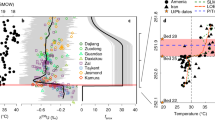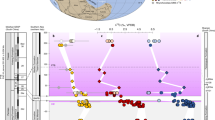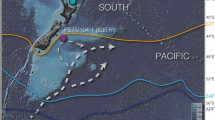Abstract
The start of the Palaeocene/Eocene thermal maximum—a period of exceptional global warming about 55 million years ago—is marked by a prominent negative carbon isotope excursion that reflects a massive input of 13C-depleted (‘light’) carbon to the ocean–atmosphere system1. It is often assumed2 that this carbon injection initiated the rapid increase in global surface temperatures and environmental change that characterize the climate perturbation3,4,5,6,7, but the exact sequence of events remains uncertain. Here we present chemical and biotic records of environmental change across the Palaeocene/Eocene boundary from two sediment sections in New Jersey that have high sediment accumulation rates. We show that the onsets of environmental change (as recorded by the abundant occurrence (‘acme’) of the dinoflagellate cyst Apectodinium) and of surface-ocean warming (as evidenced by the palaeothermometer TEX86) preceded the light carbon injection by several thousand years. The onset of the Apectodinium acme also precedes the carbon isotope excursion in sections from the southwest Pacific Ocean8 and the North Sea, indicating that the early onset of environmental change was not confined to the New Jersey shelf. The lag of ∼3,000 years between the onset of warming in New Jersey shelf waters and the carbon isotope excursion is consistent with the hypothesis that bottom water warming caused the injection of 13C-depleted carbon by triggering the dissociation of submarine methane hydrates1,9,10, but the cause of the early warming remains uncertain.
This is a preview of subscription content, access via your institution
Access options
Subscribe to this journal
Receive 51 print issues and online access
$199.00 per year
only $3.90 per issue
Buy this article
- Purchase on Springer Link
- Instant access to full article PDF
Prices may be subject to local taxes which are calculated during checkout


Similar content being viewed by others
References
Dickens, G. R., O’Neil, J. R., Rea, D. K. & Owen, R. M. Dissociation of oceanic methane hydrate as a cause of the carbon isotope excursion at the end of the Paleocene. Paleoceanography 10, 965–971 (1995)
Pagani, M., Caldeira, K., Archer, D. & Zachos, J. C. An ancient carbon mystery. Science 314, 1556–1557 (2006)
Kennett, J. P. & Stott, L. D. Abrupt deep-sea warming, palaeoceanographic changes and benthic extinctions at the end of the Palaeocene. Nature 353, 225–229 (1991)
Zachos, J. C. et al. A transient rise in tropical sea surface temperature during the Paleocene-Eocene thermal maximum. Science 302, 1551–1554 (2003)
Tripati, A. & Elderfield, H. Deep-sea temperature and circulation changes at the Paleocene-Eocene thermal maximum. Science 308, 1894–1898 (2005)
Sluijs, A. et al. Subtropical Arctic Ocean temperatures during the Palaeocene/Eocene thermal maximum. Nature 441, 610–613 (2006)
Sluijs, A., Bowen, G. J., Brinkhuis, H., Lourens, L. J. & Thomas, E. in Deep Time Perspectives on Climate Change: Marrying the Signal from Computer Models and Biological Proxies (eds Williams, M., Haywood, A. M., Gregory, F. J. & Schmidt, D. N.) 323–349 (The Micropalaeontological Society Special Publication, The Geological Society, London, 2007)
Crouch, E. M. et al. Global dinoflagellate event associated with the late Paleocene thermal maximum. Geology 29, 315–318 (2001)
MacDonald, G. J. Role of methane clathrates in past and future climates. Clim. Change 16, 247–281 (1990)
Xu, W., Lowell, R. P. & Peltzer, E. T. Effect of seafloor temperature and pressure variations on methane flux from a gas hydrate layer: Comparison between current and late Paleocene climate conditions. J. Geophys. Res. 106, 26413–26423 (2001)
Koch, P. L., Zachos, J. C. & Gingerich, P. D. Correlation between isotope records in marine and continental carbon reservoirs near the Palaeocene/Eocene boundary. Nature 358, 319–322 (1992)
Higgins, J. A. & Schrag, D. P. Beyond methane: Towards a theory for the Paleocene-Eocene thermal maximum. Earth Planet. Sci. Lett. 245, 523–537 (2006)
Bujak, J. P. & Brinkhuis, H. in Late Paleocene-Early Eocene Climatic and Biotic Events in the Marine and Terrestrial Records (eds Aubry, M.-P., Lucas, S. G. & Berggren, W. A.) 277–295 (Columbia Univ. Press, New York, 1998)
Thomas, E. & Shackleton, N. J. in Correlation of the Early Paleogene in Northwestern Europe (eds Knox, R. W. O. B., Corfield, R. M. & Dunay, R. E.) 401–441 (Geological Society of London Special Publication 101, Geological Society of London, London, 1996)
Svensen, H. et al. Release of methane from a volcanic basin as a mechanism for initial Eocene global warming. Nature 429, 542–545 (2004)
Thomas, D. J., Zachos, J. C., Bralower, T. J., Thomas, E. & Bohaty, S. Warming the fuel for the fire: Evidence for the thermal dissociation of methane hydrate during the Paleocene-Eocene thermal maximum. Geology 30, 1067–1070 (2002)
Zachos, J. C. et al. Rapid acidification of the ocean during the Paleocene-Eocene thermal maximum. Science 308, 1611–1615 (2005)
Cramer, B. S. & Kent, D. V. Bolide summer: The Paleocene/Eocene thermal maximum as a response to an extraterrestrial trigger. Palaeogeogr. Palaeoclimatol. Palaeoecol. 224, 144–166 (2005)
Stoll, H. M. Limited range of interspecific vital effects in coccolith stable isotopic records during the Paleocene-Eocene thermal maximum. Paleoceanography 20 10.1029/2004PA001046 (2005)
Cramer, B. S. et al. An exceptional chronologic, isotopic, and clay mineralogic record of the latest Paleocene thermal maximum, Bass River, NJ, ODP 174AX. Bull. Soc. Geol. Fr. 170, 883–897 (1999)
Zachos, J. C. et al. The Palaeocene-Eocene carbon isotope excursion: Constraints from individual shell planktonic foraminifer records. Phil. Trans. R. Soc. A 365, 1829–1842 (2007)
Schouten, S., Hopmans, E. C., Schefuß, E. & Sinninghe Damsté, J. S. Distributional variations in marine crenarchaeotal membrane lipids: A new tool for reconstructing ancient sea water temperatures? Earth Planet. Sci. Lett. 204, 265–274 (2002)
Wuchter, C., Schouten, S., Coolen, M. J. L. & Sinninghe Damsté, J. S. Temperature-dependent variation in the distribution of tetraether membrane lipids of marine Crenarchaeota: Implications for TEX86 paleothermometry. Paleoceanography 19 10.1029/2004PA001041 (2004)
Schouten, S. et al. Extremely high sea-surface temperatures at low latitudes during the middle Cretaceous as revealed by archaeal membrane lipids. Geology 31, 1069–1072 (2003)
Zachos, J. C. et al. Extreme warming of mid-latitude coastal ocean during the Paleocene-Eocene thermal maximum: Inferences from TEX86 and isotope data. Geology 34, 737–740 (2006)
Kvenvolden, K. A. Methane hydrate — a major reservoir of carbon in the shallow geosphere? Chem. Geol. 71, 41–51 (1988)
Dickens, G. R. Rethinking the global carbon cycle with a large, dynamic and microbially mediated gas hydrate capacitor. Earth Planet. Sci. Lett. 213, 169–183 (2003)
Milkov, A. V. Global estimates of hydrate-bound gas in marine sediments: How much is really out there? Earth Sci. Rev. 66, 183–197 (2004)
Lourens, L. J. et al. Astronomical pacing of late Palaeocene to early Eocene global warming events. Nature 435, 1083–1087 (2005)
Storey, M., Duncan, R. A. & Swisher, C. C. Paleocene-Eocene thermal maximum and the opening of the northeast Atlantic. Science 316, 587–589 (2007)
Acknowledgements
This research used samples and/or data provided by the Integrated Ocean Drilling Program. A.S. thanks the Utrecht Biogeology Center, the LPP Foundation and The Netherlands Organisation for Scientific Research (NWO, VENI-grant) and J.C.Z. thanks the National Science Foundation for funding. E. Hopmans and A. Mets (NIOZ) are thanked for analytical assistance with TEX86 measurements. A. van Dijk, E. van Bentum, C. Blaga, R. Deltrap, D. Menzel, G. Nobbe, J. van Tongeren, N. Welters (all Utrecht University) and D. Andreason and T. Quattlebaum (UC Santa Cruz) are thanked for advice and support regarding analyses. We thank J. Browning, K. Miller, J. Firth and G. Esmay for help regarding the logistics around sampling the Bass River section and E. Thomas for sampling the Wilson Lake section. ConocoPhillips, P. van Veen in particular, is thanked for enabling us to use their North Sea cores. I. Harding, M. Huber, L. Lourens and M. Pagani are thanked for discussions.
Author Contributions A.S., H.B. and J.C.Z. designed the research, A.S. and H.B. carried out the palynology, A.S., G.-J.R. and H.B. the δ13CDINO and δ13CTOC analyses, A.S., S.S., G.J.R. and J.S.S.D. the TEX86 analyses. S.M.B., C.M.J. and J.C.Z. generated the isotope data on carbonate. All authors contributed to interpreting the data and writing the paper.
Author information
Authors and Affiliations
Corresponding author
Supplementary information
Supplementary Information
The file contains Supplementary Notes with Supplementary Figures S1-S4, additional references and Supplementary Table S1. (PDF 693 kb)
Rights and permissions
About this article
Cite this article
Sluijs, A., Brinkhuis, H., Schouten, S. et al. Environmental precursors to rapid light carbon injection at the Palaeocene/Eocene boundary. Nature 450, 1218–1221 (2007). https://doi.org/10.1038/nature06400
Received:
Accepted:
Issue Date:
DOI: https://doi.org/10.1038/nature06400
This article is cited by
-
A study on benthic molluscs and stable isotopes from Kutch, western India reveals early Eocene hyperthermals and pronounced transgression during ETM2 and H2 events
Swiss Journal of Palaeontology (2022)
-
Enhanced ocean oxygenation during Cenozoic warm periods
Nature (2022)
-
Astrochronology of the Paleocene-Eocene Thermal Maximum on the Atlantic Coastal Plain
Nature Communications (2022)
-
Paleodepositional and Hydrocarbon Source-Rock Characteristics of the Sonari Succession (Paleocene), Barmer Basin, NW India: Implications from Petrography and Geochemistry
Natural Resources Research (2022)
-
The PhanSST global database of Phanerozoic sea surface temperature proxy data
Scientific Data (2022)
Comments
By submitting a comment you agree to abide by our Terms and Community Guidelines. If you find something abusive or that does not comply with our terms or guidelines please flag it as inappropriate.



